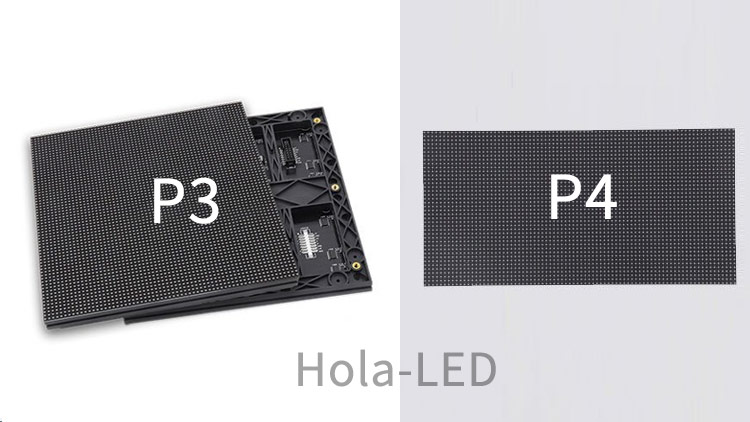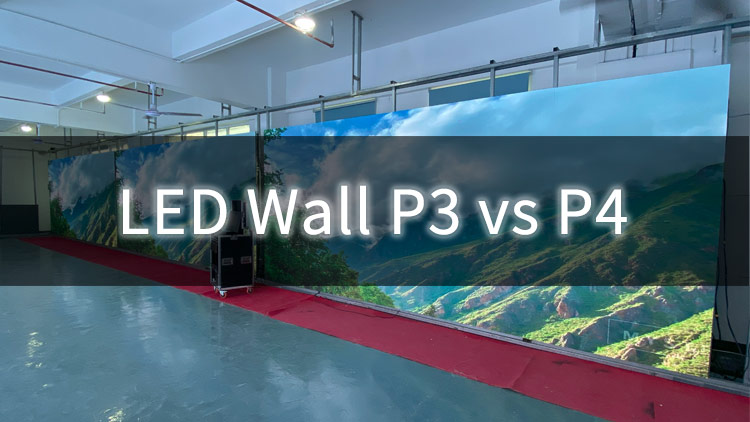LED walls have become ubiquitous in our daily lives, appearing in major shopping malls, exhibition halls, and conference venues. Yet different LED walls possess distinct characteristics. This article explains the LED wall p3 vs p4 to help you gain a deeper understanding and make an informed choice.
What is a P3 LED Wall?
A P3 LED wall is composed of P3 LED modules. With a smaller pixel pitch, it can form a higher-resolution display. It delivers optimal performance for close-range viewing and is ideal for venues demanding high image quality, such as conference rooms, exhibition halls, and large shopping malls.
What is a P4 LED Wall?
A P4 LED wall utilizes P4 LED modules with a larger pixel pitch. This design better accommodates viewing from greater distances, making it ideal for expansive settings like outdoor advertising, music stages, commercial venues, or sports arenas.

The difference between LED Wall P3 vs P4
Pixel Pitch
Pixel pitch refers to the distance between the centers of adjacent LED diodes on the wall. P3 LED walls have a 3mm pixel pitch, while P4 LED walls feature a 4mm pixel pitch. This indicates that P3 LED walls have a shorter pixel pitch, resulting in a denser pixel arrangement.
Viewing Distance
Differences emerge between P3 and P4 LED walls at varying viewing distances. Within 10 meters, P3 LED walls deliver superior visual performance compared to P4 LED walls. The optimal viewing distance for P3 LED walls is 3 to 4.5 meters, while P4 LED walls are best viewed from 4 to 5.5 meters. Consequently, P3 LED walls are more suitable for smaller spaces, whereas P4 LED walls perform better in larger areas.
Resolution
Resolution is closely tied to pixel pitch. Generally, denser pixel points yield higher resolution and sharper image quality.
The P3 LED wall boasts a higher pixel density, reaching 111,111 dots per square meter. Consequently, when selecting LED walls of the same size, the P3 LED wall delivers sharper, more refined, and lifelike visuals. The P4 LED wall has a relatively lower pixel density of 62,500 dots per square meter, resulting in slightly less clarity.
Refresh Rate
There is no inherent difference in refresh rate between P3 and P4 LED walls. This primarily depends on the type of IC selected. High-performance ICs can achieve a refresh rate of 3840Hz, delivering a superior viewing experience.
Cost-Effectiveness
Compared to P4 LED walls, P3 LED walls feature denser pixel points, requiring more LED lamps and consequently incurring higher costs. Since P3 LED wall modules cost more than P4 LED wall modules, P3 LED walls are slightly pricier than P4 LED walls.
Lifespan
Both P3 and P4 LED walls boast a lifespan of 100,000 hours. However, actual longevity may vary based on environmental conditions and usage patterns.

LED Wall P3 vs P4: How to Choose?
There is no absolute superiority between P3 and P4 LED walls; their suitability depends on the application. If your space is relatively compact with a short viewing distance, and you desire sharper image quality, opt for a P3 LED wall. Conversely, if your space is larger with a longer viewing distance, a P4 LED wall is the better choice.



